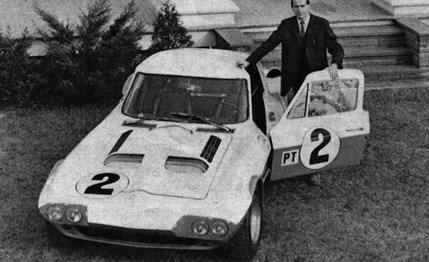
 Specialty File
Specialty File
Originally published in Car and Driver magazine in April 1967.
David Erwin of Painted Post, New York, describes himself as a "Chevy man." There are "Ford men" and "Plymouth men" and "Pontiac men," but Erwin and the close-knit group of friends who gather nightly to labor over one of the rarest of all Chevrolets remain loyal to that marque.
David Erwin could also be cast as a "Ferrari man." A tall, reserved banker, and the heir of a prominent family of landed gentry whose holdings date back to the Revolution, Erwin is the sort of precise, well-bred young man whose fascination with the Maranello product is practically a foregone conclusion. In fact, one stall in Erwin's comfortable workshop behind the family's large, colonnaded homestead is occupied by one of the last GTO lightweights ever built.
But the machine stabled beside the Ferrari is the one that keeps "Chevy man" Erwin and his friends turned on. This is one of the fabled "Grand Sport" race cars, a four-wheeled passenger pidgeon whose existence bears testimony to those mystery-shrouded days when Chevrolet was committed to winning every major sports car race in the world, including Le Mans.
Ever since the spring of 1963, when General Motors summarily cancelled all competition activities, the Corvette Grand Sport has established itself as one of the most fascinating enigmas in motor racing annals. Periodically, one of the five examples Chevy built has appeared at places like Sebring or Nassau, has raced around at shocking speeds, and then has plunged back into mysterious seclusion. People are still talking about how the Jim Hall/Roger Penske Grand Sport stunned the Fords and Ferraris by leading the early laps of the 1964 Sebring 12-Hour, and how Penske thrashed the late Ken Miles and his Cobra 427 prototype at Nassau later the same year.
These rare outings, though impressive, never did the machines full justice, because GM's anti-racing policy was so effective than never once did a Grand Sport reach the race track at the level of readiness that Chevrolet engineers had intended. That the cars were so impressive when they were finally raced - both outdated and underpowered - can only make one pause to wonder how overwhelming they might have been if Chevrolet had been permitted to carry out the full Grand Sport program with corporate blessing.
The Grand Sport was a direct development of the 1958 FIA ruling that limited international sports/racing cars to three liters engine displacement. Up until that moment, Chevrolet had been hard at work on some exotic big-engined sports/racers, the last of which, the Corvette SS, ran at the 1957 Sebring race in the hands of Piero Taruffi and John Fitch. Seeing no benefit to passenger-car engineering in perfecting a 3-liter racing engine, Chevrolet stayed away from road racing until their resident competition wizard, Zora Arkus-Duntov, spotted a loophole in the FIA rules that would permit Chevrolet's return. Because no displacement limits were set on GT cars, Duntov and his talented design group set out to build a lightweight, big-engined Grand Tourer that would be powerful enough to win not only the GT class, but also the supposedly faster sports/racing category as well. The goal was no less than an overall victory at the Le Mans 24-hour classic.
Chevrolet, still shying away from an all-out racing car disguised as a GT car, wanted their Grand Sport to look like a production car - in this case, their brand new Sting Ray. Duntov and his Corvette engineers reckoned that it would take 600 horsepower to push the Sting Ray up the straight at Le Mans at a competitive top speed, 4-wheel disc brakes to slow it down, and a vehicle weight of 1800 lbs. to achieve competitive lap times.